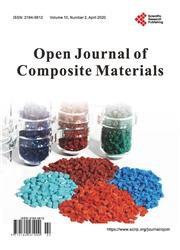Improvement in Impact Energy Absorption of UD-CFRP by Sub-Micron Glass Fiber into Its Matrix
引用次数: 1
Abstract
CFRPs have high strength despite low density, but little impact resistance. In addition, the debonding of the interface between reinforcement fiber and matrix causes one of the fractures of FRPs. Therefore, the purpose of this study is to investigate the interfacial bonding characteristics between the reinforcement fiber and matrix of FRPs, not only under static loading but also under dynamic loading. Moreover, an effective method to improve the impact resistance of FRPs from the viewpoint of interfacial bonding characteristics was proposed. First, two types of UD-FRPs in which the reinforcement fiber was glass fiber or carbon fiber, were prepared to investigate the energy absorption under a bending load. A bending load was applied to the specimen statically and dynamically to measure the energy absorption until failure. The interfacial bonding characteristics between the reinforcement fiber and matrix were measured using a fragmentation method with a single fiber-embedded specimen. A dynamic tensile load was applied to the specimen using a tensile-type split Hopkinson pressure bar apparatus. Test results showed that the energy absorption of UD-CFRP decreased with an increase in strain rate, whereas that of UD-GFRP increased with an increase in strain rate. When the epoxy resin was modified by adding sub-micron glass fiber, both the interfacial shear strength between the carbon fiber and matrix, and the energy absorption of UD-CFRP improved.亚微米玻璃纤维对UD-CFRP冲击吸能的改善
cfrp虽然密度低,但强度高,抗冲击性差。此外,增强纤维与基体界面的脱粘是frp断裂的主要原因之一。因此,本研究的目的是研究frp增强纤维与基体在静载荷和动载荷作用下的界面结合特性。从界面结合特性的角度出发,提出了提高frp抗冲击性能的有效方法。首先,制备了两种增强纤维分别为玻璃纤维和碳纤维的ud - frp,研究了其在弯曲载荷下的吸能性能。对试件施加静、动态弯曲载荷,测量其在破坏前的能量吸收。采用单纤维嵌套试样破碎法测量了增强纤维与基体之间的界面结合特性。采用拉伸式霍普金森压杆装置对试样施加动态拉伸载荷。试验结果表明,UD-CFRP的吸能随应变速率的增大而减小,UD-GFRP的吸能随应变速率的增大而增大。添加亚微米玻璃纤维对环氧树脂进行改性后,碳纤维与基体之间的界面抗剪强度和UD-CFRP的吸能性能均有所提高。
本文章由计算机程序翻译,如有差异,请以英文原文为准。
求助全文
约1分钟内获得全文
求助全文

 求助内容:
求助内容: 应助结果提醒方式:
应助结果提醒方式:


